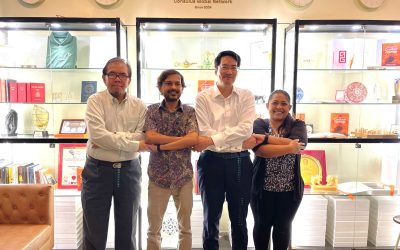A region of rich diversity faced with rising fault lines means it cannot be business as usual for such initiatives.
By Lawrence Chong and Karkal Karthik
On the 9th of May, as the ground shook and toppled the ruling party of Malaysia, the aftershocks threaten to ground the fast-tracked infrastructure projects – estimated at USD$120 Bn – that Najib once touted would help the country leap into the league of advanced nations. Governments in the region watched the scenes in Kuala Lumpur unfold in disbelief as the Malaysian economy was growing at 5.5% and various infrastructure projects, once implemented, would unleash exponential benefits for the economy. But obviously the people thought otherwise. For them good governance and the dignity as Malaysians mattered more and the proposed economic benefits did not trickle down to them fast enough.
Smart city and high-tech infrastructure presentations have a tendency to be a pitch for an advanced future hoping to inspire hope with the promise of transforming the livelihood of millions. With jargons such as drones, big data and IoT often thrown about with abandon, there are still too few solutions to address the jarring fault lines in ASEAN. Such presentations can appear tone deaf. It is as if the conditions are perfect for one to simply bring in the investments or take on debt for the best technologies and future-ready infrastructures then miracles of economic inclusion will happen.
Fortunately the ASEAN governments are deeply aware of these fault lines and want to change the conversation to be more inclusive. In April, the governments launched the ASEAN Smart Cities Network. Recognising that most of the region’s growth will continue to be driven by urban centres, the proposal said:
“However, this rapid urbanisation is not without its challenges as it has implications on important issues such as city congestion, water/air quality, poverty, rising inequalities, urban-rural divide, citizen security and safety.”
The ASEAN Smart Cities Network (ASCN) has a sensible objective which is to be “a collaborative platform where up to three cities from each AMS, including capitals – with room for expansion when it matures – work towards the common goal of smart and sustainable urban development.”
In our view, sustainable urban development will require that governments and developers acknowledge the challenges in ASEAN so as to develop right-sized solutions.
Challenges in ASEAN
Upward mobility will matter
ASEAN has a large proportion of youth and this means that upward mobility will matter. But low wage growth amid high costs in construction for smart city projects will burden future generations. How projects will help young couples secure a home and participate in smart cities will matter.
Greying population
At the same time, as quality of healthcare has improved in ASEAN, a rising proportion of the population will join the silver club. So ensuring that the future is not just for the young but also for the elderly will matter. This means making sure that smart cities will allow mobility, and access to quality and affordable healthcare for the elderly.
Racial and religious tensions
ASEAN is deeply diverse in terms of culture and religion. Most smart city projects lack consideration for cultural and religious representation. It almost seems that a smart city of the future has no place for the richness and diversity of ASEAN. This is insensitive as ASEAN is going through a period of tensions linked to race and religion.
Growing Debt Crisis
One of the key points highlighted by Dr Mahathir during his election campaign is that he is worried about Malaysian being forever indebted to China due to the large infrastructure projects. Sensible and sustainable financing plans will matter as a number of governments in the region lack the financial resources to commit to such projects.
Designing Sustainable and Smart Cities for ASEAN
Therefore, ASEAN with its multitude of opportunities and challenges will need more than just a tech or infrastructure-led approach for smart cities. It will require smart governance, inclusive economic and urban development strategies. From our experience in advising and working on Smart City projects in the region, here are some of our thoughts:
SHAPING FUTURE IDENTITIES FOR ASEAN SMART CITIES
Issues – Many smart city projects seem to undertake a commodity approach without forging unique identities. Overused images of drones and self-driving vehicles are such examples. For a region shaped by different cultural and religious influences, our language, food and rituals have been richly enhanced and united. At the same time, we cannot avoid being shaped by the events and powers of the world: terrorism, religious extremism, tug-and-pull of present and ancient powers that seek to shape the development here. The ASEAN smart cities network seems to place a greater emphasis on implementation and financing projects rather than invest in nurturing shared identities.
Opportunities – There is therefore an urgent need to bring out the interconnectedness of our identity as the people of ASEAN. From food, arts, to cultural and religious practices, we have influenced one another for good. Therefore smart cities also need to project a shared identity about food, culture, arts and faith, in order to contribute to the soft power development of an enriched ASEAN. The ASEAN smart cities network should include a shared depository of content that will encourage creativity, culture and people of faith to help shape a distinct ASEAN identity for smart cities.
URBAN INNOVATION BY DESIGN FOR ASEAN
Issues – For centuries or even for a couple of millennia, cities have been built by people in power, be it monarchs or political leaders. Cities were planned and designed to meet their needs for holding back an army, showcasing their power and wealth, and creating places for economic activity and living. All of these were done with a single purpose by a few experts on scales that were so big, that it would be impossible for anyone to understand the detailed impact of such plans. They were very successful when the people shaping them had control over the few parameters of that society and their activities. But in a rapidly globalising world, which has seen more innovations in all fields, where the future of economic activity will be shaped by Industry 4.0 and the focus is on citizens and their overall physical and mental well-being, there is a greater need for innovation in the urban sector.
Opportunities – The great news is that, urban innovations are already happening all around us, albeit in many cases being small and in a fragmented manner. The innovations in the urban sector come from expertise like technology, finance, land policy, planning, real estate, design and many more. But what is missing is the system thinking from a city planning perspective that is able to maximise the impact of these innovations. This calls for leaders in both the public and private sectors dealing with city development to work together to make this a reality. There is no better place to start this than in the ASEAN countries where there is comparatively more political stability within the countries and with the neighbours; a unique way of life; and an admirable natural environment that needs preserving. We as the residents and experts of cities believe that such a reality is possible in Southeast Asia.
IMPLEMENTATION AND DEVELOPMENT FOR ASEAN SMART CITIES
Issues – In many of the ASEAN countries, plans are made at multiple levels of the government and even within the private sector. The issue sometimes is not that there is no plan, but there is no implementation roadmap for those plans to be realized. Those unrealised plans in most cases amplify one of the most crucial challenges in the urban sector – the need for more emphasis on the implementation mechanisms in order to ensure that we are indeed preparing ourselves for the myriad challenges posed by rapid urbanisation in the ASEAN countries.
Opportunities – Learning from other successful projects around the world, there are many examples and case studies that provide us with the potential mechanisms that focus on implementation. These examples are mostly in the form of special purpose vehicles created by governments in collaboration with the private sector – what we call Public-Private Partnerships. These partnerships are comprehensive, in the sense they have a clear organisational structure; an innovative legal provision; clear funding sources supported by robust economic and financial models; a clear value proposition to attract potential investors; an unencumbered land boundary for development; and lastly the governments will to see it through. Currently many of these are created for large-scale infrastructure projects and special economic zones that have heightened industrial activity. But these special purpose vehicles give us a hope that such well-intentioned and implementable plans will find its way into more urban development projects in the future.
If you are concerned about the issues above and shaping a sustainable smart city development in ASEAN, we will have a conference on this issue on the 6th of July. Held in partnership with Design Singapore Council, we have assembled regional experts and business owners from the region to think differently about Smart City projects.
Find out more about Shape the World Conference here
Lawrence Chong is the CEO at Consulus, a Singapore-headquartered Innovation firm specialising in Industry 4.0 transformation. As part of its global portfolio of solutions, the firm implements business and creative solutions for Smart Cities in ASEAN.
Karkal Karthik is the Senior Vice-President at CPG Consultants. He leads the firm’s urban planning and design division. He has extensive experience in ASEAN providing strategies and implementation approaches for Smart City projects.
CPG and Consulus are alliance partners for an integrated solution for Smart Cities named PlaceCORE.




